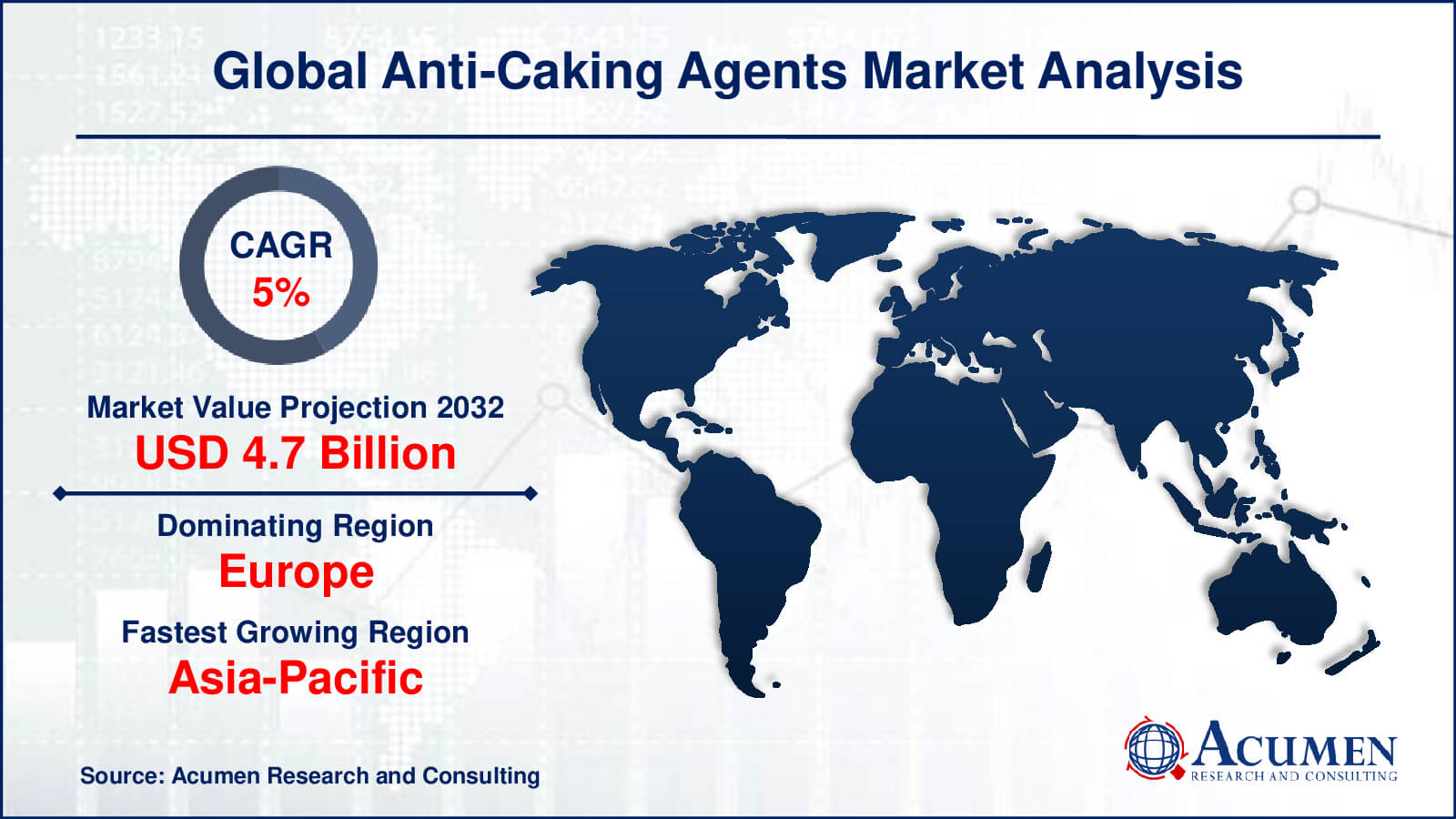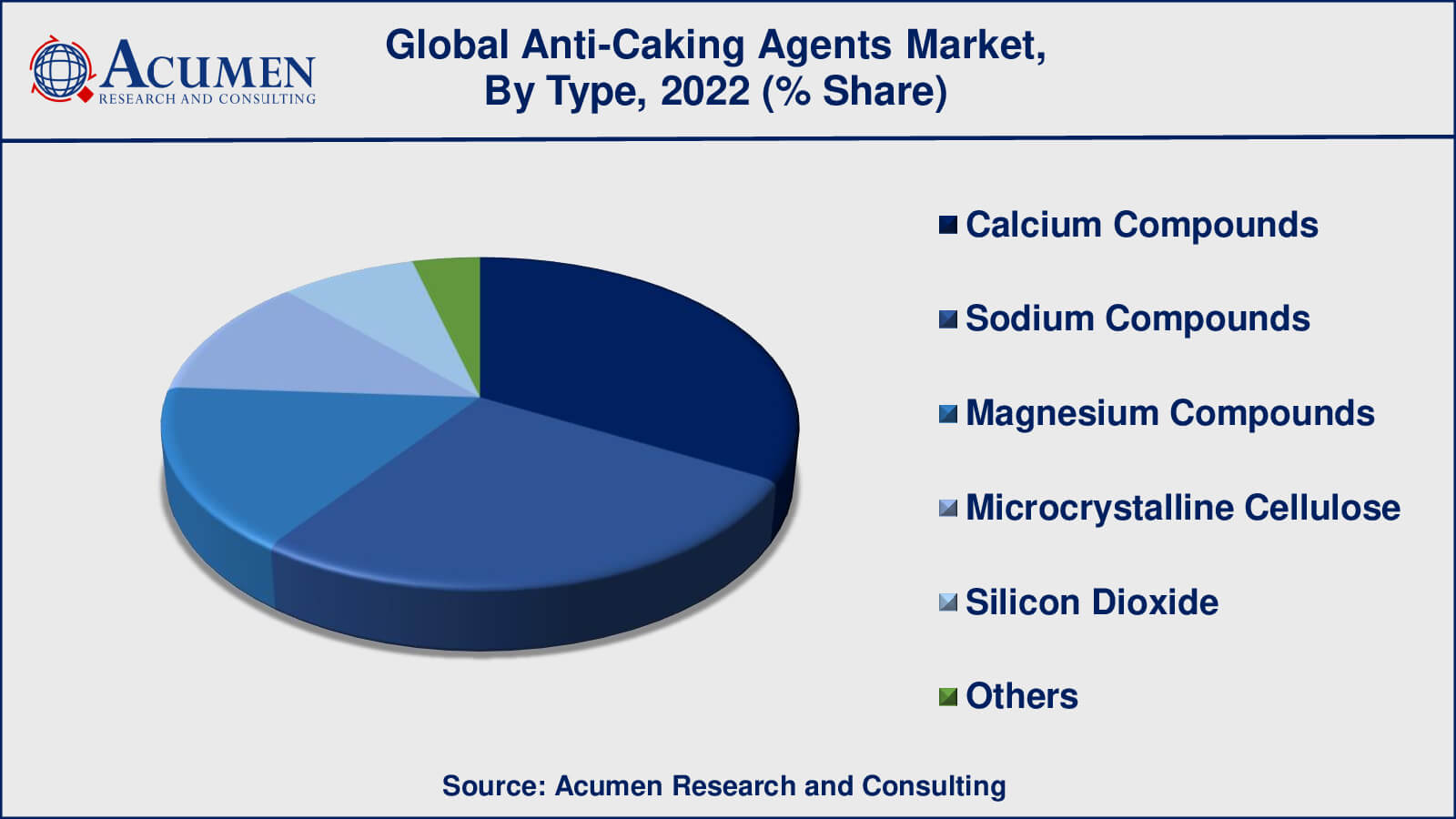Anti Caking Agents Market | Acumen Research and Consulting
Anti-Caking Agents Market Size - Global Industry, Share, Analysis, Trends and Forecast 2023 - 2032
Published :
Report ID:
Pages :
Format :
The Global Anti-Caking Agents Market Size collected USD 3.1 Billion in 2022 and is set to achieve a market size of USD 4.7 Billion in 2032 growing at a CAGR of 5% from 2023 to 2032.
Anti-Caking Agents Market Report Statistics
- Global anti-caking agents market revenue is estimated to reach USD 4.7 billion by 2032 with a CAGR of 5% from 2023 to 2032
- Europe anti-caking agents market value occupied more than USD 1.1 billion in 2022
- Asia-Pacific anti-caking agents market growth will record a CAGR of over 5% from 2023 to 2032
- Among source, the synthetic sub-segment generated around 56% share in 2022
- Based on type, the paper and packaging generated US$ 1 billion revenue in 2022
- Increasing focus on product development and innovation is a popular anti-caking agents market trend that fuels the industry demand

Anti-caking agents are additives that are available in the form of granulated or powdered materials that aid in preventing the formation of lumps. They are dissolvable in alcohol and water among others. Anti-caking agents create a water-repellent coating or absorb excess moisture on the powdered particles. They are applied in powdered products for ease of consumption, transport, and packaging. However, they do not possess any nutritional value. The high adaptability of anti-caking agents is one of the key factors expected to push the demand for this market during the forecast period. Additionally, the increasing demand for convenience /packaged foods, which is backed by the increasing purchasing power of consumers, is another major contributing factor to the overall growth of the anti-caking market at the global level. Further, the growth of the anti-caking market is also attributed to the increasing demand for fast food, takeaway, and processed food, and innovation through extensive research and development activities.

Global Anti-Caking Agents Market Dynamics
Market Drivers
- Increasing demand in food and beverage industry
- Rising awareness about food safety and quality
- Growing use in non-food applications
- Increasing demand for convenience foods
Market Restraints
- Stringent government regulations
- Side effects of anti-caking agents
- Availability of natural alternatives
Market Opportunities
- Growing demand in developing countries
- Growth in pharmaceutical industry
- Government regulations
Anti-Caking Agents Market Report Coverage
| Market | Anti-Caking Agents Market |
| Anti-Caking Agents Market Size 2022 | USD 3.1 Billion |
| Anti-Caking Agents Market Forecast 2032 | USD 4.7 Billion |
| Anti-Caking Agents Market CAGR During 2023 - 2032 | 5% |
| Anti-Caking Agents Market Analysis Period | 2020 - 2032 |
| Anti-Caking Agents Market Base Year | 2022 |
| Anti-Caking Agents Market Forecast Data | 2023 - 2032 |
| Segments Covered | By Source, By Application, And By Geography |
| Regional Scope | North America, Europe, Asia Pacific, Latin America, and Middle East & Africa |
| Key Companies Profiled | Agropur Ingredients, Brentagg A.G., Cabot Corporation, Evonik Industries, J.M. Huber Corporation, Kao Corporation, PPG Industries Inc., Solvay S.A., and Univar Inc. |
| Report Coverage |
Market Trends, Drivers, Restraints, Competitive Analysis, Player Profiling, Covid-19 Analysis, Regulation Analysis |
Anti-Caking Agents Market Growth Factors
Stringent regulations set by the government are likely to inhibit the growth of the anti-caking agents market. Further, the health hazard of anti-caking agents is another major factor barring the growth of this market at present. However, untapped markets are expected to pose a suitable opportunity for the growth of the anti-caking agents market in near future, by allowing major manufacturers to penetrate emerging economies. This owes due to the exponential growth of the food and beverage industry, even in emerging economies.
Anti-Caking Agents Market Segmentation
The worldwide anti-caking agents market is categorized based on source, type, application, and geography.
Anti-Caking Agents Market By Source
- Natural
- Synthetic

According to the anti-caking agents industry analysis, synthetic anti-caking agents dominate the anti-caking agents market. Synthetic anti-caking agents are generally less expensive to produce and more effective than natural anti-caking agents at preventing caking and clumping. They also have a longer shelf life, which makes them a popular choice among manufacturers of processed foods and convenience products. Some of the common anti-caking agents available in the market are powdered cellulose, sodium bicarbonate, calcium ferrocyanide, sodium ferrocyanide, stearic acid, and tricalcium phosphate among others. Sodium aluminosilicate is an anti-caking agent used in table salts. Additionally, it also finds applications in dried milk, egg mixtures, flours, and sugar products.
Organic and sustainable products, including natural anti-caking agents, are becoming increasingly popular. Natural anti-caking agents are becoming more popular as consumers become more health-conscious and alert of the potential side effects of synthetic anti-caking agents. As a result, natural anti-caking agents such as magnesium carbonate, calcium carbonate, and rice hulls have been developed and commercialized.
Anti-Caking Agents Market By Type
- Calcium Compounds
- Sodium Compounds
- Magnesium Compounds
- Microcrystalline Cellulose
- Silicon Dioxide
- Others

According to our findings, calcium and sodium compounds hold the majority of the market share for anti-caking agents. Calcium compounds, such as calcium carbonate and calcium silicate, are commonly used in the food and beverage industries to prevent caking and improve powder and granule flowability. Other industries that use them include fertilisers, feed, and pharmaceuticals. As anti-caking agents, sodium compounds such as sodium bicarbonate and sodium ferrocyanide are also commonly used. They're especially good at keeping salts, spices, and seasoning blends from caking and clumping. Magnesium compounds such as magnesium carbonate and magnesium silicate are also widely used as anti-caking agents, particularly in the food and beverage industries.
Anti-Caking Agents Market By Application
- Food and Beverage
- Bakery and Confectionery
- Dairy Products
- Spices and Seasonings
- Soups and Sauces
- Others
- Feed
- Fertilizers
- Cosmetics and Personal Care Products
- Pharmaceuticals
- Others
According to the anti-caking agents market forecast, the food and beverage industry will dominate the anti-caking agents market in terms of application. Anti-caking agents are widely used in the food and beverage industry to prevent caking and clumping in various products such as salts, spices, seasoning blends, powdered drink mixes, and other dry food ingredients. The bakery and confectionery industry is one of the largest users of anti-caking agents, particularly in the production of powdered sugar and cake mixes. The dairy industry also uses anti-caking agents to prevent caking and clumping in powdered milk and cheese products. Apart from the food and beverage industry, anti-caking agents are also used in other industries such as feed, fertilizers, cosmetics and personal care products, and pharmaceuticals.
Anti-Caking Agents Market Regional Outlook
North America
- U.S.
- Canada
Europe
- U.K.
- Germany
- France
- Spain
- Rest of Europe
Asia-Pacific
- India
- Japan
- China
- Australia
- South Korea
- Rest of Asia-Pacific
Latin America
- Brazil
- Mexico
- Rest of Latin America
The Middle East & Africa
- South Africa
- GCC Countries
- Rest of the Middle East & Africa (ME&A)
Anti-Caking Agents Market Regional Analysis
The anti-caking agents market in Asia-Pacific is expected to witness significant growth on account of the rising demand for food and beverage items among consumers. Furthermore, several emerging countries such as India, Japan, and China are the prime targets for penetration by major manufacturers. North America and Europe are matured markets for anti-caking agents and these regions are majorly driven by numerous applications of anti-caking agents in processed food items. However, regulations set by the European Food and Safety Authority (EFSA) for barring the development of anti-caking agents are likely to hinder the European market. The increasing demand for processed foods coupled with rapid demand for dairy products in Argentina and Brazil is likely to complement the growth of anti-caking agent markets in Latin America.
Anti-Caking Agents Market Players
The global anti-caking agents market is marked by intense competition from major players operating in this industry. Frequent joint ventures and partnerships, mergers and acquisitions, and innovation through extensive research and development activities are few of the key strategies adopted by these players to sustain in the market. Agropur Ingredients, Brentagg A.G., Cabot Corporation, Evonik Industries, J.M. Huber Corporation, Kao Corporation, PPG Industries Inc., Solvay S.A., and Univar Inc. are some of the key players operating in this industry.
Frequently Asked Questions
How big is the bone void fillers market?
The anti-caking agents market size was USD 3.1 Billion in 2022.
What is the CAGR of the global anti-caking agents market during forecast period of 2023 to 2032?
The CAGR of anti-caking agents market is 5% during the analysis period of 2023 to 2032.
Which are the key players operating in the market?
The key players operating in the global market are Agropur Ingredients, Brentagg A.G., Cabot Corporation, Evonik Industries, J.M. Huber Corporation, Kao Corporation, PPG Industries Inc., Solvay S.A., and Univar Inc.
Which region held the dominating position in the global anti-caking agents market?
Europe held the dominating position in anti-caking agents market during the analysis period of 2023 to 2032.
Which region registered the fastest growing CAGR for the forecast period of 2023 to 2032?
Asia-Pacific region exhibited fastest growing CAGR for anti-caking agents market during the analysis period of 2023 to 2032.
What are the current trends and dynamics in the global anti-caking agents market?
The current trends and dynamics in the anti-caking agents industry include increasing demand in food and beverage industry, rising awareness about food safety and quality, and growing use in non-food applications.
Which source held the maximum share in 2022?
The synthetic source held the maximum share of the anti-caking agents market.



